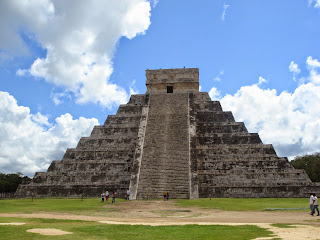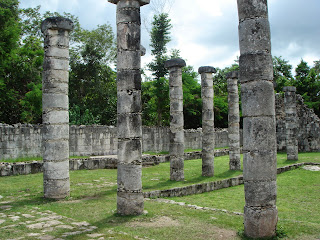In 1517 El Conquistador Bernal Diaz de Castillo, who at that time was living in Santiago de Cuba, started his journey in the quest of new lands and Diego Velasquez, the governor of Cuba furnished them three ships. The Captain chosen by them was Francisco Hernandez de Cordoba, a rich merchant of Cuba. He and his party discovered the shores of Yucatan, they first landed at Punta de Cotoche (Campeachy) where, after skirmishes with the natives, they captured two Indians and brought them to Havana (Cuba). There they were closely questioned by the governor Diego Velasquez as to whether there were any gold mines in their country. The Mexicans were shown the gold dust which was found in Cuba, and the Indians answered in the affirmative. But this proved to be untrue. (Memoirs of the Conquistador Bernal Diaz de Castillo-(written by himself) published in 1632. ---
The Spaniards had seen Maize fields in Cotoche, the two Indians who were christianised and named Melchor and Julian, were shown the plants of Cassava root, which was grown in Cuba and was called Yuca. Cuban made bread from the Cassava flour. The Indians nodded and assured the governor and the people assembled there that indeed such roots grew in their country too and was called TALE.The Spaniards who were assembled around the governor Velasquez, told him, in the confusion of the sign languages and pronunciation of the words, that the Indians called their country Yucatan. From these two words, Yuca+tale came the name Yucatan. And the name stuck(memoirs of Bernal Diaz). ---
It was Mayas who traversed Mexico and arrived in Yucatan and who started the construction of such beautiful temples and other monuments in Campeche, Tabasco, Chiapas and Quintana Roo, which were parts of Yucatan. The Spaniards were so astonished at the civilised ways of the Mayans, their stone built houses, cities with wide avenues, markets full of abundant merchandise, their art of making cloth etc, that they named the capital Merida, in memory of the city of the same name in Spain, which also is an archaeological wonder with ruins and remains of Roman architecture. Chichen-Itza ( which means at the mouth of the water well Itza. ----
Itza was a large city in pre-Colombian days built by Mayans and it is one of the most visited sites of Mexico. In Yucatan much of the population still speak Mayan language but I could not find out what was the original Mayan name for the peninsula. The Mayans built their pyramids with stone and the most famous is the Kukulkan pyramid, renamed El Castillo by the Spaniards.The four sides of the Kukulkan pyramid contain 365 steps in total 91 steps per side and the final 365th step on top representing the solar year, 52 panels for each year in the Mayan century as well as each week in the solar year, and 18 terraces (for the 18 months in the religious year). The height of the pyramid is more than 12 meters, and is a monumental representation of the Mayan calendar. --
Mayan structures in Chichen Itza were built for different purposes, there is the astronomical Observatory El Caracol, the imposing Temple of Warriors, the reclining statue of Chac Mool, a classic Maya sculpture, believed to have served as an altar for sacrifices, and the Nunnery,probably inhabitated by the nobility and the ruling class, with two patios and a Ball game court decorated with reliefs featuring players. There are the remains of El Templo de los Tableros, the name of the building comes from the reliefs carved on the walls of the Colonnade,depicting scenes of people, plants, animals (both real and imaginary) dominated by two warriors. ---
Then there is the Plataforma de las Tumbas(Platform of the Tombs) the funerary structure, which probably served as a storage for human bones, since bones were also unearthed from other tombs. Most noteworthy features of this structure are the colums that rise up out of the mother rock and sustain a roof and a serpentine frieze which adorns the upper part of the platform. There is a path which connects the Northern path with the observatory "El Caracol", which was built in three stages (Sacbeoob 5&15)which is connected with the Temple of Xtoloc, the main Diety of the Mayans. This temple which is the largest in the centre of Cichhen-Itza, decorated with bass reliefs of birds, animals and mythological scenesand a large container, where archeolgists had found human remains. The temple was used for religious ceremonies. --
La Plaza de las Mil Columnas (the Plaza of 1000 columns) with its steam bath building, with inner bathing chambers, waitng rooms with heating stones tell us about the social life of the Mayans, their knowledge, meaning and understanding of the worldly and celestial beings. There are numerous buildings to see at Chichen-Itza. -
The Yucatán Peninsula is a limestone plain, with no rivers or streams. The region is pockmarked with natural sinkholes, called cenotes, which expose the water table to the surface. One of the most impressive of these is the Cenote Sagrado, which is 60 metres (200 ft) in diameter,[54] and sheer cliffs that drop to the water table some 27 metres (89 ft) below.
The Cenote Sagrado was a place of pilgrimage for ancient Maya people who, according to ethnohistoric sources, would conduct sacrifices during times of drought.[54] Archaeological investigations support this as thousands of objects have been removed from the bottom of the cenote, including material such as gold, carved jade, copal, pottery, flint, obsidian, shell, wood, rubber, cloth, as well as skeletons of children and men. There are dense forests surrounding many sites and the whole area has a mystry about it. A local guide, who was explaining the history of Mayans to a group of french tourists told us that there were many undiscovered temples and pyraminds in that area which had not been discovered yet because of density of the forests. Many local people were sitting and carving wooden statues of their dieties and their workmanship was superb. The wooden statues were beautiful and we also bought one. The statue is of Aztec Diety Humming Bird "Huitzilopochtl", the god of sun and patron of war and fire.












No comments:
Post a Comment